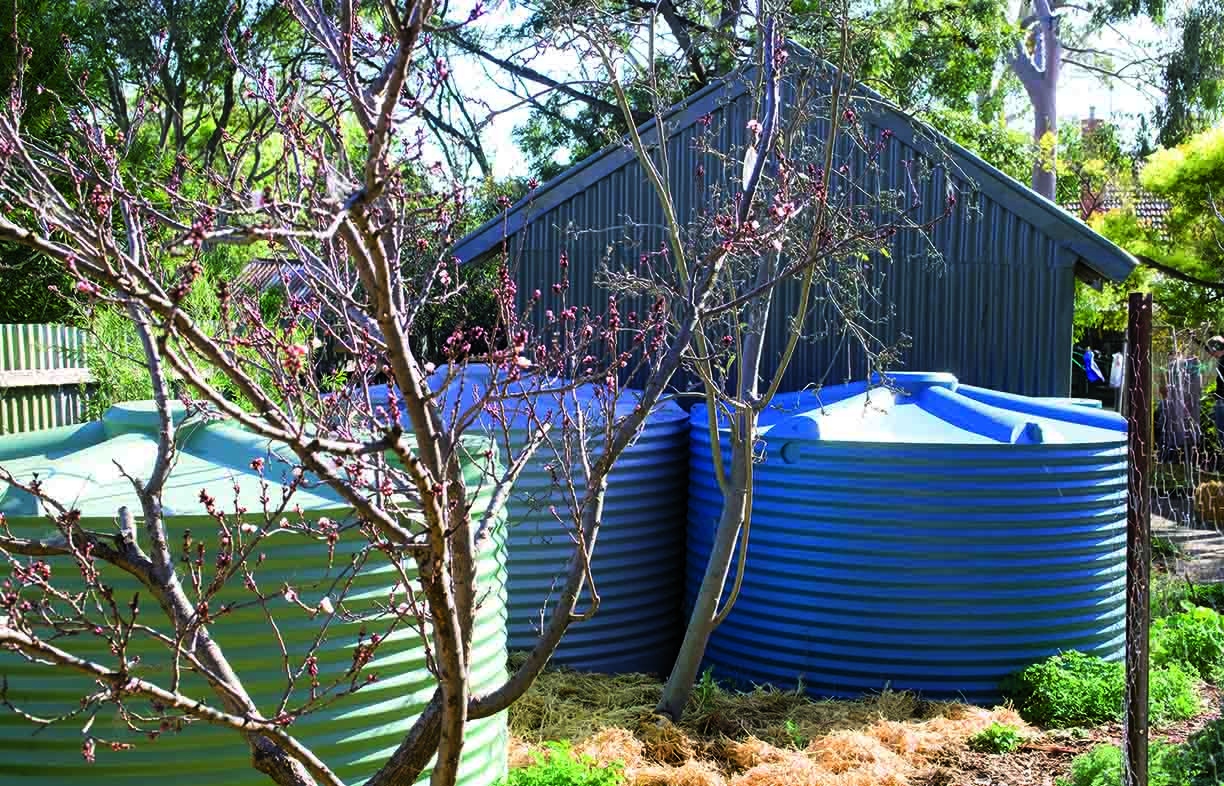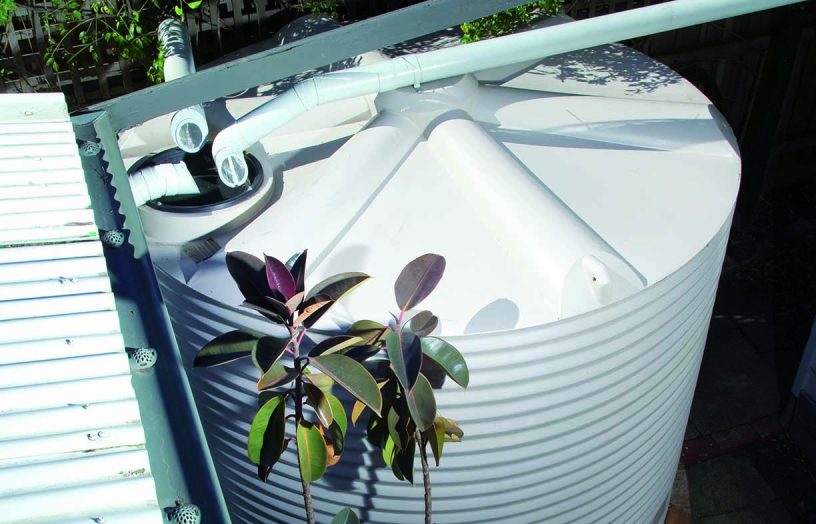Getting rainwater collection right

During the millennium drought many people installed water tanks for the first time – it really wasn’t common in cities before then. Ten years on, as we face drought again, what do we know about the best ways to optimise rainwater collection for your site? Stuart McQuire shares the latest.
With below average rainfall across the country this winter, and Australia experiencing its driest September on record, now is the perfect time to check that your rainwater system is working as well as it can be for the summer ahead – or to take the plunge and install one. What do you need to consider?
Build upon your current system
Do you have a tank that’s not quite doing the job? It’s possible a pump, additional tanks or maybe just cleaning your roof and gutters could help you get more out of your rainwater supply.
At our house in Melbourne, we now have four rainwater tanks that hold 20,300 litres in total for use in the bathroom, kitchen, laundry and garden, but we didn’t jump straight to this point. We started small, buying a secondhand tank to catch water from the bungalow roof so that we could water the garden. We soon found the limits of the tank, as it would be full for six to nine months of the year when we didn’t need to water the garden, and it would quickly empty when the hot dry weather came. Next we connected a larger tank to collect water from the house roof, purchased a pressure pump and had the rainwater plumbed to the laundry, one of the toilets and a garden tap. The pump provided pressure when we needed it and we had access to rainwater for everyday use, which is when our mains water consumption, and bills, started to decrease. We eventually had the rainwater connected to the hot water supply, leaving only the kitchen and bathroom cold taps on mains water. If the rainwater tanks run dry in prolonged dry periods we are able to switch to mains supply.
Maximise your rainwater collection
There might be some downpipes at your house not being used for rainwater collection, that if connected to a tank could increase your rainwater harvest. Look at adding individual rainwater tanks to these downpipes. It’s possible to use small tanks in this way, combined with a larger storage tank that isn’t necessarily near the house to create one storage space for water and increase the roof area you are using as catchment. The tanks can be interconnected at ground level using 32mm polyethylene pipe if care is taken to align the top levels of the tanks.
Use Renew’s Tankulator tool to run through some water use scenarios. This online rain harvesting calculator can help you plan for a new rainwater tank or improve the performance of an existing tank.
Consider a pressure pump
A pressure pump increases the flow rate of the water, allowing you to use rainwater in more places inside your home and out in the garden. Pressure controllers are used with pumps so that the pump switches on and off automatically; for instance, if you flush the toilet the pump will come on, and then it will shut off when the toilet cistern is full. Pressure controllers also safeguard the pump from overheating if the rainwater tank runs dry.
Find out more about pressure pumps and controllers in the Rainwater Tank Buyers Guide in issue 145 of Renew magazine.
Start using rainwater in the house
With upgrades like a pump in hand you might decide that your rainwater could be put to better use elsewhere; a garden tank could be plumbed to the laundry for example. Relatively small rainwater tanks, just 2500 or 5000 litres in size, can supply large amounts of water to fixtures used regularly inside the house such as toilets, laundry and hot water systems. The tank gets more use this way as it partially empties when water is used, so that more water can be collected next time it rains. To use rainwater in the house, a licensed plumber will need to install new plumbing connections to the pipe network.



Be confident that your rainwater is clean
Proper maintenance of your rainwater harvesting area and connecting pipes can help you collect more rainwater and improve the quality at the same time. Make sure your gutters and pipes are unblocked and do not contain leaves and debris so rainwater can freely flow into your tank. Gutter guards can be used to prevent leaves and debris entering the guttering, which can be useful if your roof has overhanging or nearby trees. However, maintenance is still required as some gutter guards still allow leaves to gather on the roof. Be sure to regularly check the inlet strainer at the top of the rainwater tank to make sure it is not getting blocked up.
First-rain diverters send the first bit of rain away from the rainwater tank along with any accumulated contaminants from the roof or guttering, and the bonus is that the water can be sent straight to the garden. Remember to clean first-rain diverters and tank inlet filters regularly to remove any accumulated sediment or other material.
Over time, sediments accumulate at the bottom of the tank so health authorities recommend desludging rainwater tanks every two to three years, or earlier if sediment is evident in the water flow. With a clean roof catchment and gutters, the tank won’t need to be desludged as often. Fortunately desludging can be done without emptying the tank or getting inside the tank if you use a siphon, pump or vacuum instead. Water Not Down the Drain has further details on desludging, otherwise seek out a tank cleaning professional – a local rainwater tank agent might be able to give a recommendation.
It’s been a progression for us to go from water wasters to sustainable water users. A rainwater tank is a great asset that can be built upon over time to bring down water use even further.
Related articles
 Outdoors
Outdoors
Pocket forests: Urban microforests gaining ground
Often no bigger than a tennis court, microforests punch above their weight for establishing cool urban microclimates, providing wildlife habitat and focusing community connection. Mara Ripani goes exploring.
Read more Outdoors
Outdoors
Nourished by nature: Garden design for mental health and wellbeing
There’s plenty of evidence that connection with nature is beneficial for both mind and body. We speak to the experts about designing gardens for improved mood and wellbeing, and what we can do at home to create green spaces that give back in a therapeutic way.
Read more


